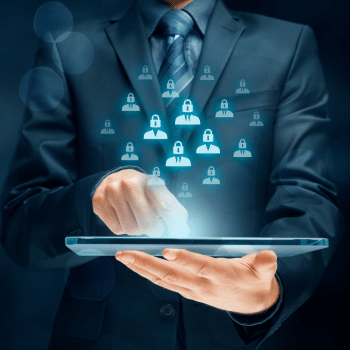What can cybercriminals do with my personal data?
 In our digitalized world, personal data has become a valuable currency for cybercriminals. But what exactly can be done with this sensitive information?
In our digitalized world, personal data has become a valuable currency for cybercriminals. But what exactly can be done with this sensitive information?
Cybercriminals can use your personal data in several illicit ways. Here are some of the most common uses:
Identity theft
One of the most damaging uses of personal data is identity theft. Cybercriminals can get their hands on information like the name, ID, social security number, and bank details to assume a person's identity. They are then able to create fake profiles on social networks, open bank accounts, or sell products online, among other things.
Financial fraud
With bank and credit card details in hand, cybercriminals can perform fraudulent transactions, which include:
-
Improper online purchases;
-
Bank transfers;
-
Loan applications;
-
Among others
Extortion
Cybercriminals may resort to threats such as the disclosure of sensitive information, like cell phone numbers, home addresses, or even intimate photos, forcing victims to pay a ransom to avoid exposure.
Cyberattacks
Criminals often use illegally acquired personal data to make social engineering and phishing scams seem more convincing. Furthermore, they can also use this data for brute-force attacks, since most people use personal data to create their passwords.
Put up for sale on illegal or untraceable websites and forums
Stolen personal data is often sold on parallel digital markets or secret forums on the dark or deep web. Prices vary depending on the rarity and potential use of the data.
How cybercriminals get hold of this data
Scammers use an array of methods to acquire personal data. Some of them are:
Social networks
Public profiles on social networks are a hotbed for cybercriminals on the prowl for personal data. People often take photos of concert tickets, plane tickets, their workplace, etc., and share these images on social media.
Phishing attacks and social engineering
Cybercriminals can send fake emails, and messages or make phone calls pretending to be legitimate institutions to trick victims into sharing confidential information or clicking on a malicious link.
Data leaks
Institutions, websites, and applications that require accounts or registrations may be the target of cyberattacks and consequently experience data leaks.
Buying data on illegal or untraceable websites and forums
It is often possible to acquire entire lists of leaked personal data and even bank details, which can be used to launch mass phishing campaigns and countless other scams.
How to protect your personal data in the digital environment
1) Use strong passwords
Use strong passwords, with at least 12 characters, using a combination of upper and lower case letters, numbers, and special characters. Consider using two-factor authentication as an extra layer of security, along with password managers.
2) Privacy settings
Review and adjust privacy settings on social networks and other online platforms, thereby minimizing the amount of personal information shared publicly.
3) Digital awareness
Precaution and knowledge are the best defenses against the threats lurking in cyberspace. Learning how to identify phishing attempts and other scams is vital to being able to protect your data online. Never click on links or provide personal information, use a reliable antivirus, and verify suspicious contacts through other channels.
Conclusion
With the increasing flow of information, protecting personal data is a must. By adopting digital security practices and being aware of the risks, we can significantly reduce the risk of falling victim to cybercriminals hunting for personal information.
